The world of Shadow Hills Industries takes high quality discrete audio paths with versatile controls to meet the demands of modern recording and wraps them with striking antique military aesthetics. The vintage-inspired knobs and heavy-duty mechanical switches inspire users to explore all tonal options Shadow Hills units can offer. With rugged construction and superior components, they will serve for years to come. From GAMA mic preamps, Dual Vandergraph and Mono Optograph compressors, innovative summing/monitor controllers like the Equinox, and all the way up to the top of the line Mastering Compressor, Shadow Hills manufactures hardware that lets engineers really grab ahold of their recordings.

Mastering Compressor
Mastering-grade compressor/limiter for tracking and mixing
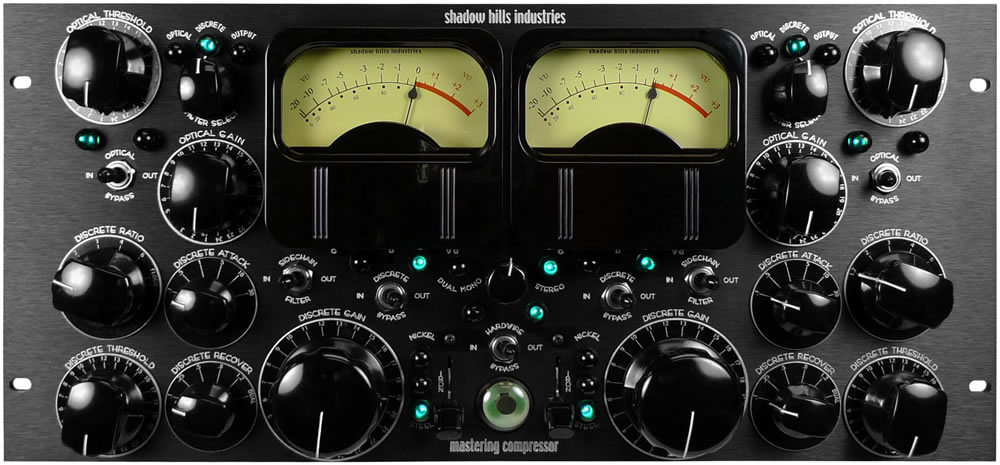
The Shadow Hills Mastering Compressor has extraordinary functionality, and also provides mastering grade compression and limiting for tracking and mixing. Essentially it is two compressors in series, per channel, that can act in stereo, or dual mono. First comes our mastering grade electro optical compressor, followed by our discrete Class-A compressor/limiter. Both feed our switchable custom output transformers, Nickel, Iron, and Steel. There is enough gain in each section to overdrive the hottest tape, or clip your converters, if you're into that sort of thing.
The input stage is transformer balanced, followed by our fully discrete optical compressor. This section utilizes the same T4B optical attenuator as the LA2A and LA3A, but is optimized for mastering. The second stage is our discrete Class-A VCA compressor. There are no electrolytic caps or IC chips in the audio path. There are six ratios: 1.2 to 1, 2 to 1, 3 to 1, 4 to 1, 6 to 1, and 10 to 1. There is six attack settings: .1, .5, 1, 5, 10, and 30 milliseconds. And there are six release times selectable: .1, .25, .5,8, 1.2, and Auto. There is an insertable filter in the side chain to limit pumping with bass heavy material. Lastly the signal goes through our new Shadow Hills custom transformer-switching network.
The first position is Nickel, which is our custom version of a famous L. A. custom console. Next is Iron. In this mode the signal goes through our op-amp and into a Class-A output stage then to our custom Iron transformers, the last transformer position is Steel. These selections allow you to choose between different output transformers that are in effect: clean, colored, and dirty, respectively.
The optical section has a hard-wired bypass that completely removes it from the signal path, and the Class-A VCA compressor is also hardwire bypassable, completely removing it from the chain. It is possible to independently bypass both compression sections and have your signal go through the input transformer and transformer selector only. There is also a hardwire bypass for the entire compressor, effectively a strait wire in and out of the box. So besides being a mastering grade, and highly functional buss compressor, it serves as an excellent tracking compressor.
For instance, you might call up the chain of the optical compressor, then to the Class-A output and Iron transformer, for vocals, or select just the Class-A VCA compressor with a 10:1 plus the Steel transformer for crushing some room mics, and on and on.
The metering can reflect, optical gain reduction, discrete gain reduction, or output level. The Magic eye tube follows the output meter to act as a peak meter.
All 17 of the rotary switches are detented. The front panel is engraved. The knobs are bake-lite.
The Equinox
Mic pre, summing mixer and monitor section all in one

The Shadow Hills Equinox is like a complete small-format recording console in just 2 rack spaces. It features 2 GAMA mic preamps, 30 channels of analog summing, and a mastering-grade monitor controller.
Microphone Preamp
The mic preamps are the Golden Age Microphone Amps. Each has 60dB of gain, 24 position gold-plated stepped attenuators, 48V Phantom Power, 20 dB Pad, Phase Reverse, and 1/4” DI Input. The most exciting feature of the amplifier section is the switchable output transformers, which allow for several different sonic flavors in the same box. The transformers and characteristics are as follows:
Steel Transformer (hand wound to match a favorite 1970's American output transformer.) Tight and punchy, the most colored with the biggest low end. The sound of rock and roll. Nickel Transformer (hand wound transformer based on a L.A. custom console.) Super clear and wonderful sounding, but with a subtle and musical smoothing of the transients. Iron Transformer (modern version of the classic St. Ives 1166 Neve output transformer.) - Warm and round, with a super detailed and present mid-range.
Summing Network
The summing buss is a 30-channel mixer utilizing copper buss bars and esoteric resistors, for simply the finest sounding passive summing. DAW inputs 3-24 are STEREO summed and distributed odd to left and even to right, while DAW inputs 25-32 are sent MONO to both channels of the summing network. The summed signal then passes through the Golden Age amplifiers with selectable output transformers. Effectively allowing the user to choose between the sounds of three different consoles on the mix bus.
Monitor Section
The monitor section features: choice of 4 input sources, choice of 3 speaker outputs, 24 step Monitor Level control, Monitor Level DIM switch, switch to engage built-in Talkback Mic, Cue output, and Stereo/Mono switch.
With the INPUT SELECT switch IN:
DAW 1-2 position the Equinox monitors the stereo mix output of the user’s DAW. In this mode, the incoming DAW 1-2 signal bypasses the GAMA amplifiers and feeds the Monitor Level control. This allows the user to employ the Equinox’s mic preamps standalone and record/monitor them through the DAW’s I/O.
MIX 3-32 position, the Equinox monitors the summing network after passing through the GAMA’s.
EXTERNAL position, the Equinox is able to monitor an additional balanced stereo source via rear panel XLR connections.
MIC PRE position, the Equinox routes the mic preamp output directly to the Monitor Section. This allows the user to monitor the signal coming directly from the preamp, prior to any converter artifacts or intermediate processing.
The monitor section also features 3 pairs of Speaker Outputs and a Cue (or headphone) Output. Both reproduce what the Input Select is set to. Only one speaker output pair may be selected at a time. The speaker output level is control by the Monitor Level knob. The Cue Output is unaffected by the Monitor Level, and switches to the Talkback signal when the Talkback Switch is engaged. Simultaneously, the Monitor Level dims when the Talkback Switch is engaged.
With all these features in a rugged 2U enclosure the Shadow Hills Equinox is equipped for the demands of modern recording, but styled and crafted to the high standards of a bygone era.
Dual Vandergraph
Fully discrete 500 Series stereo compressor
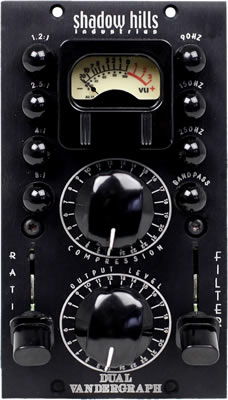
The Shadow Hills Dual Vandergraph is a direct descendant of the Shadow Hills Mastering Compressor and maintains its reputation of unquestionable quality and exceptional performance - in a 500 Series format. It’s inner workings are developed from the discrete gain cells of the Mastering Compressor which are combined with the Optograph’s extremely flexible Sidechain Filter matrix. This combination provides great possibilities for new recording techniques and the dynamic control.
This stereo compressor’s fully discrete audio path is Class-A and features Shadow Hills' custom Iron Transformers.
The controls are: Ratio, Filter, Compression and Output Level.
Just like the Mastering Compressor, the Compression and Output Level controls are Swiss made twenty-four position attenuators. The Ratio switch, selects between: 1.2: 1, 2.5: 1, 4: 1, 8: 1.
In addition to changing ratios, each selection changes preset attack and recover times.
The Sidechain Filter Matrix controls the frequency sensitivity of the side-chain. The positions are: 90 hertz, 150 hertz, 250 hertz and Bandpass.
- Input impedance 20k
- Minimum load impedance 600 ohms
- Stereo
- Fully Class-A
- Discrete audio path
- Discrete gain cells from Mastering Compressor
- Sidechain Filter Matrix from Optograph
- Swiss made discrete attenuators
- Military Spec build quality
- Meets the specifications of the VPR Alliance
Mono Optograph 500
Single-channel 500 Series discrete optical compressor
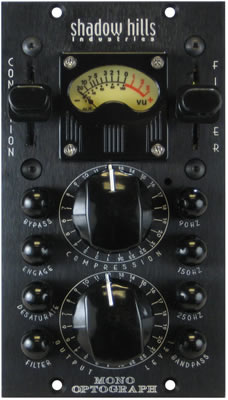
Two channel inductor based parametric equalizer featuring Class A solid state circuitry and a special saturation section with models for mastering and recording.
This single channel discrete optical compressor in the API 500 Series form factor takes its cues and much of its design from the optical stage of its behemoth big brother, the Shadow Hills Mastering Compressor. The Mono Optograph's front end is balanced by an original Jensen input transformer. The output utilizes our specially recreated Nickel transformer. The essence of the compressor's character comes from our custom electroluminescent cell and discrete op-amp combination. The high quality circuit is pristine enough for bus compression, and yet has a unique character reminiscent of an antique world class compressor, that has just now been discovered. It's also perfect for squeezing drum busses and massaging vocals. It's the perfect glue for tracking and mixing anything that needs to sound more finished, more like a record.
Just like The Mastering Compressor, the Optograph's threshold and make up gain are controlled by discrete attenuators, made from custom twenty-four position Elma switches. The tactile feel and quality of these controls are unrivaled. They are of the highest quality and will last forever.
Built into the side chain, are a very powerful series of filters: 90 hertz, 150 hertz, 250 hertz, and band pass. By engaging a specific filter, you choose at which point the onset of compression occurs. First position, nothing below ninety triggers compression. Second position, nothing below one-fifty. Third, nothing below two-fifty. The fourth position is a musical bandpass filter. In this position, compression is triggered by the program's mid-range frequency content, ignoring the highest and lowest frequencies. The filters are amazingly useful for shifting the focus of what should be more compressed and creating compression curves on purpose.
Another unique feature for sculpting the overall sonic character is the Transformer Desaturate mode. In this mode we cancel out any distortion and frequency non-linearity’s caused by the output transformer. The result is a pure, almost transformer-less sound, whilst still receiving the benefits, of limiting transients that can only come from magnetics.
There is also a VU meter for the display of gain reduction. The Optograph is enclosed in a twelve gauge steel chassis, has an engraved front panel and custom made knobs.
Features:
- Pristine sound quality and unique character
- Switchable sidechain filters
- Transformer Desaturate
- Detented switches
- Engraved front panels
Mono Gama Mic Pre
500 Series Golden Age Mic Amp with selectable transformer options
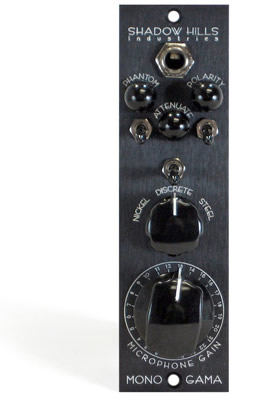
The Mono GAMA is the single-channel API 500 Series version of the Golden Age Microphone Amp, with all the capabilities, features, and quality of the original. The Shadow Hills Mono Gama is centered around our custom discrete op-amp. This no-compromise design exudes hugeness, fidelity, punchiness and depth, across the full frequency range, without becoming veiled or choked.
The preamplifier input is transformer balanced and utilizes an original Jensen input transformer. We couldn't decide which vintage output transformer we liked best, so we had our favorites perfectly recreated, and included them all. You can change the output transformer by cranking the knob, thus changing the tonal capabilities to compliment to whatever material you are recording. This allows you to audition different settings to find the perfect match for microphone or direct input without patching and un-patching other preamps, and possibly alleviating the need for EQ. Choose between Nickel, Discrete, or Steel settings. Each transformer position is stellar unto itself, but the capability of switching between them is like having three great pre's in one.
All the standard Mic-pre features are present: phantom power, phase reverse, a twenty dB pad, and direct input. We have also included the ability to pad and reverse the phase of the Direct Input.
Quality is unmatched. Engraved front panels, a twenty four position swiss made attenuator for gain control, custom made knobs, and engraved serial number plates, set the build apart.
Features:
- Superb sound quality and character
- Switchable output transformers
- Stepped attenuator for gain control
- Phase reversible and padable DI
- Engraved front panels
- 75 ma current draw per module
Power Supply
PSU for Equinox, Quad Gama, Mastering Compressor, or Optograph

The new and improved Shadow Hills Power Supply for Equinox, Quad Gama, Mastering Compressor, or Optograph.
Quad Gama w/Iron Mod
Four-channel microphone preamp

The Shadow Hills Quad GAMA is a four channel version of the Gama, with all the capabilities, features, and quality of the original.
The Gama Is centered around our custom discrete op-amp. This no-compromise design exudes hugeness, fidelity, punchy-ness and depth, across the full frequency range, without becoming veiled or choked, the way non-discrete varieties can.
The preamplifier input is transformer balanced and utilizes an original Jensen input transformer. We couldn't decide which vintage output transformer we liked best, so we had our favorites perfectly recreated, and included them all. You can change output transformers with the flick of a switch, thus changing the tonal capabilities to compliment to whatever material you are recording. This allows you to audition different settings to find the perfect match for microphone or direct input without patching and un-patching other preamps, and possibly alleviating the need for EQ. Choose between Nickel, Discrete, or Steel settings, or upgrade the Discrete to Iron. Each transformer position is stellar unto itself, but the capability of switching between them is like having three great pre's in one.
The microphone gain is controlled by discrete attenuators made from custom twenty-four position Elma switches. This means that all of the channels are perfectly matched to each other and will never wear out like a pot can. Unlike other boutique companies that offer expensive stepped, or mastering options, but limit you to twelve positions, or use stepped pots that can fail over time, ours have twice the resolution and are included in the price.
All the standard Mic-pre features are present: phantom power, phase reverse, a twenty dB pad, and direct input. We have also included the ability to pad and reverse the phase of the Direct Input. The separate power supply is very robust and can power two units.
Quality is also unmatched. Twelve gauge steel chassis, engraved front panels, large custom knobs, and personalized engraved serial number plates, set the build apart. The design aesthetic is reminiscent of 1930's futuristic military technology, that has only now been realized.
Features:
- Superb sound quality and character
- Switchable output transformers
- Detented switches
- Phase reversible and padable DI
- Engraved front panels
Oculus - Wireless
Tactile monitor console with control room functionality like talk-back, autocue, and Class A headphone output - with wireless Remote Pendant controller
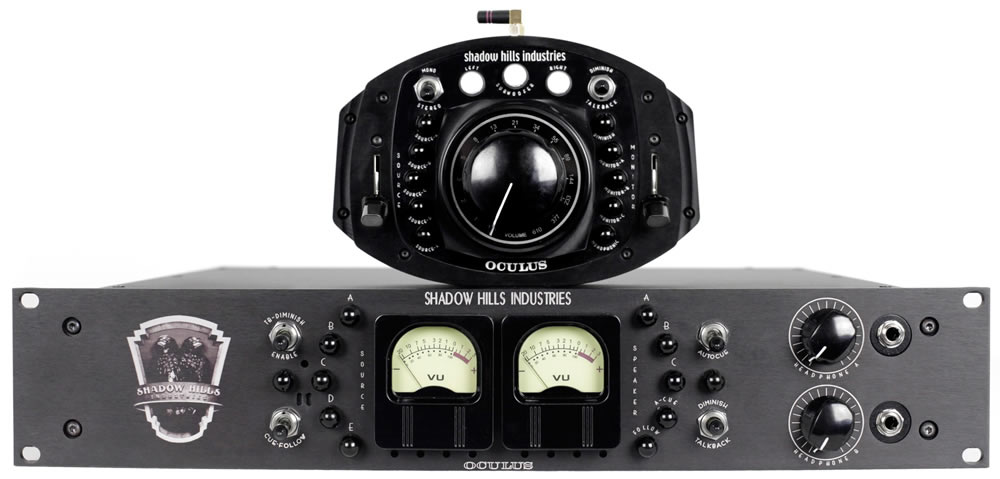
Shadow Hills Industries has done it again! The Oculus monitor controller is a striking centerpiece to your studio control room, providing crucial functionality and performing to top-notch specifications. Monitor reference level control, talkback, autocue, Class A headphone outs, and more, bring the necessary elements of your studio's workflow at your fingertips. Install the rack unit in your 19" rack and perch the Remote Pendant proudly on your desk surface or console, with wireless operation keeping things nice and tidy at your workstation.
MANUFACTURER'S DESCRIPTION:
Shadow Hills took the long road, cutting no corners and sparing no expense to make the Oculus, the finest monitor console ever made. Drawing from years of experience creating some of the most coveted mastering compressors and summing mixers, Shadow Hills designed the Oculus with an utter devotion to audio integrity. The Remote Pendant wirelessly controls the esoteric architecture and mastering-grade topologies of the Oculus. This intuitive tactile interface is machined from a solid piece of aluminum, uniting technical innovation with sonic purity to create the ultimate reference monitor controller.
Features:
- Wireless Remote Pendant
- Mastering-grade, fully-discrete passive volume attenuators for left and right monitors and subwoofer control
- Five selectable fully balanced input sources
- Class A active buffer for unbalanced source
- Three selectable stereo speaker outputs
- Adjustable speaker trims for equalizing sound pressure levels between monitors
- Dedicated subwoofer output with trim-able level for each speaker selection
- Large left and right VU meters
- Connection for external VU meters and oscilloscope
- Two Class A audiophile headphone amplifiers
- Left, right and subwoofer mutes
- Mono/Stereo selector collapses signals to mono
- Complete large format console type talkback matrix with internal and external microphones, Class A microphone preamp and remote switching
- Cue-follow for switching between external cue signals and the current input source selection
- Auto-cue automatically engages talkback when the “tape” stops rolling
- Internal Power Supply
Standard Operations:
Volume Control: The large Bakelite knob on the Remote Pendant Is the tactile interface for selecting control room volumes. The single knob simultaneously controls the left, right, and subwoofer levels by means of three distinct, discrete passive attenuators.
A properly implemented discrete passive attenuator will always provide superior sound quality over any other topology. This is why nearly every mastering suite, where the price is no object, utilizes this design.
All Mute: Pulling the Pendant volume knob up enables a full mute of the monitor outputs.
Left/Right Subwoofer Mute: The Pendant push-buttons above the volume Individually mute each speaker.
Mono/Stereo: The pendant switch for Mono/Stereo selects the mode in which signal is sent via the monitor outputs. This switch is after the Left/Right mutes. The mono signal playing out of both speaker is derived the unmuted channel or channels. Thus it is possible to hear the left channel in both speakers by muting the right channel, or vice versa. This is a true 'Mono Sum' for monitor troubleshooting and phase coherency. The 'Monophonic' LED on the Pendant is lit when the output is in mono.
Diminish: This reduces the volume in the monitors by half for ease of communication without the requirement of a 'full mute' from the monitors. The LED above the 'Diminish Talkback' switch on the base station, as well as the 'Diminish' LED on the pendant, are lit when the monitors are diminished in volume.
Talk Back Diminish Enable: When this feature is enabled, whenever Talkback is engaged, the Monitor outputs dim. If this is not enabled, then the Monitor outputs stay at normal volume while the talkback microphone is active. The LED below the 'TB-Diminish' switch is ON when the feature is enabled, and the 'Diminish' LEDs on the base station and pendant are lit when the monitor dim is occurring. This feature also works in conjunction with the 'Autocue' feature.
Auto Cue: Auto Cue is a feature by which the talkback microphone is automatically switched on when source material has stopped playing and is switched off when the source material plays. In other words, it frees the engineer from having to press the talk back switch between every take of a performance. To use the Auto Cue feature, the engineer must patch in a “play signal” into the Auto-Cue input on the back of the base station. Signals such as SMPTE time code or a -10 decibel test tone played back from a striped track are appropriate. During playback, the Talk Back function should still operate as normal. If the Talk Back switch is engaged and playback is detected, the Talk Back microphone will then be turned on. This is useful for instruction the musicians during a take.The 'A-Cue' LED is lit when this feature is enabled.
Cue Follow: On the base station, there is a separate pair of stereo outputs for headphones called the cue output. When Cue Follow is NOT engaged, the cue is always fed via Source-E, regardless of where the main source select switch is positioned. This allows the engineer to monitor a different source as the performers.
When CUE Follow is engaged, the CUE feed “follows” the source selected via the Source Select switch. For example, if the Source Selected is C, then the CUE will be fed the source C signals as well. The 'Follow' LED on the base station is lit when this function is enabled.
Class-A Active Buffer for Source A: For unbalanced feeds into the Oculus, or for any other situation where an active, buffered balanced input is needed, use Source A. Enable the Buffer by depressing the small pushbutton labeled ‘Active Buffer Engage’
External Talkback Microphone: Hook any balanced talkback microphone into the XLR input on the backplate and depress the pushbutton labeled 'External Talkback Engage' on the back panel. This disengages the internal talkback microphone and exclusively uses the external talkback microphone in its place.
Talkback Remote: This 1/4” jack on the back panel enabled an alternate trigger for engaging talkback in the Oculus. When any passive, unbalanced 1/4” switch is used that shorts the tip to ground upon activation, talkback is enabled. This remote can be used in parallel with the existing momentary 'Talkback' switches on the Pendant and Base Station.
Specifications: Monitor, Subwoofer and Cue Outputs
- Minimum Frequency Response: 1Hz – 100kHz @ -0.1dB
- THD+N: 0.001%
- IMD: < 0.001%
- Crosstalk Rejection: >97%; >-100dBu
- Passive Output Headroom: Infinite
- Class-A Output Headroom: +28dBu
Class A Headphone Amplifier
- Minimum Frequency Response: Passive: 1Hz – 100kHz @ -0.1dB
- THD+N: 0.02%
- Crosstalk Rejection: >97%; >-102dBu
